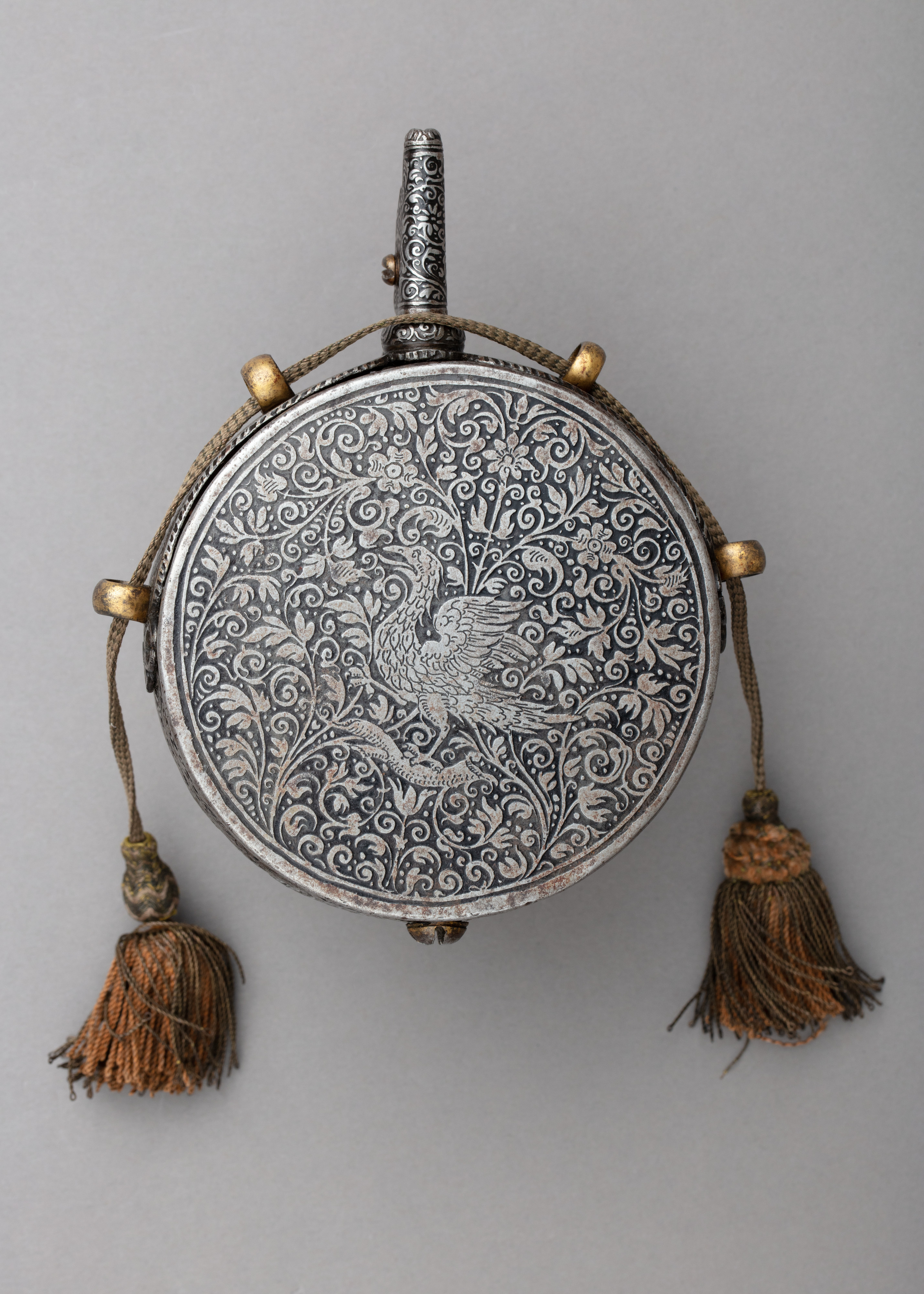Priming Flask Bearing the Monograms and Arms of the Prince-Elector August I of Saxony (reigned 1553–86) and Anna of Denmark (reigned 1553–85)
Iron-chiseler Master Thomas der Schwertfeger (possibly Thomas Rucker) German
Not on view
By the second quarter of the sixteenth century firearms were commonplace in Europe, where matchlock muskets were used by soldiers in the field while the more expensive and complicated wheellock guns and pistols were employed by mounted officers and aristocratic hunters. The finer-made weapons were often decorated and accompanied by loading and cleaning accessories of matching workmanship. Among these were gun powder containers, called flasks, of two sizes, a large one to hold the coarse-grained powder with which the barrel was charged, and a smaller one for the fine-grained powder for priming the pan of the wheellock mechanism. Apart from their practical role, flasks became the subject of elaborate decoration and often were appreciated as independent works of art. Flasks come in a great variety of shapes, sizes, and materials, and are embellished with every technique and style of decoration current in their period of manufacture.
A masterpiece of iron chiseling, this small flask, or primer, is one of the most unusual and distinctive of the sixteenth century. Unlike most examples, constructed of wood, horn, or ivory, it is fashioned entirely of iron and consists of a hemispherical front plate, a flat rear plate that overlaps it at the sides, and a nozzle fitted with a spring-operated cap and lever that is seated on a curved plate at the top. The three elements fit precisely together and are attached by screws, two on either side, whose loop-shaped heads also serve to affix carrying straps, with a conventional screw at the bottom. Every inch of its surface is covered with ornament, either chiseled in relief or etched, the somber blue-black color only subtly enlivened with touches of gilding on the screws.
The hemispherical outer face is chiseled in high relief against a stippled ground, the ornament consisting of five medallions, one in the center and the others arranged symmetrically around it, each framed by a wreath and strapwork, with masks between the medallions. The center medallion contains a scene of "Christ and the Samaritan Woman" (John 4:4–26). The surrounding medallions display (clockwise from the top): the arms of the Duchy of Saxony (barry of ten, sable and Or, with a Rautenkranz [wreath of rue] vert in bend overall); the arms of Denmark (Or, three leopards/lions passant in pale azure, crowned and armed Or, langued gules, nine lily pads gules)); a monogram consisting of two conjoined letters A, one inverted, the initials of Prince-Elector August of Saxony (1526–1586) and his wife Anna of Denmark (1548–1585); and crossed swords, emblem of the prince-elector’s hereditary office of Archmarshal of the Holy Roman Empire (per fess sable and argent, two swords gules in saltire over all). The flat back is etched with a bird perched on a branch amid dense foliate scrolls, the background blackened for contrast. The rim is chiseled in low relief with foliage and figures of a dog chasing a fox and another chasing a hare, the recessed background also darkened. The nozzle, its cap and spring-lever, and the base plate are etched with foliate scrolls against a blackened ground. The rounded molding at the base of the nozzle is etched with the letters PRVN, and one side of the nozzle cap is etched with the letters AB. The flask is suspended on a later braided and tasseled silk cord woven with metal threads.
This flask is in fact one of three almost identical examples, each differing only in the Biblical scene in the center, and in the etched ornament on the back. One of them, already in the Metropolitan Museum (acc. no. 2008.638.1) depicts in the center the Sacrifice of Isaac (Genesis 22:1–19), after an engraving by Jost Amman (1539–1591) published in 1571; the other, in the Philadelphia Museum of Art (acc. no. 1991-9-3), depicts an as yet unidentified scene a kneeling man gazing upward in prayer toward God in Heaven. No other examples are known, so it is unlikely that the flasks were made as part of the equipment of the elector’s personal guard (Trabantenleibgarde), which numbered at least fifty in the sixteenth century.
On the contrary, the elaborate design and exquisite, labor-intensive workmanship of these three flasks, their differing religious subject matter, and the display of the August and Anna’s personal monogram, in addition to the more customary arms and emblems of Saxony, suggest that they were probably made for the elector himself or at least for close companions. During August’s long reign, he was responsible for consolidating and expanding Saxon territories, founding the ducal art collection (the Green Vaults, or Grünesgewolbe), and establishing one of the richest princely armories in Europe. August’s armory included a number of arms embellished with intricately chiseled iron by several local masters, but there is currently too little evidence to identify the workmanship of this flask with any of them. The attribution is further complicated by the presence of the etched inscriptions, PRUN and AB, found only on this example, which do not correspond to any of the documented iron chiselers.
Due to rights restrictions, this image cannot be enlarged, viewed at full screen, or downloaded.
This artwork is meant to be viewed from right to left. Scroll left to view more.



